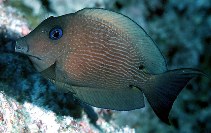| Family: |
Acanthuridae (Surgeonfishes, tangs, unicornfishes), subfamily: Acanthurinae |
| Max. size: |
22 cm TL (male/unsexed) |
| Environment: |
reef-associated; marine; depth range 0 - 60 m |
| Distribution: |
Indo-Pacific: East Africa to the Tuamoto Islands, north to southern Japan, south to central New South Wales (Australia) and New Caledonia. Not known from the Red Sea, Gulf of Oman, the Gulf, the Hawaiian Islands, Marquesas, Rapa, Pitcairn Islands, and Easter Island. |
| Diagnosis: |
Dorsal spines (total): 8-8; Dorsal soft rays (total): 24-27; Anal spines: 3-3; Anal soft rays: 22-25. Prominent black spot at the rear base of dorsal and anal fins; adults with a bluish ring around the eye (Ref 1602). Dorsal and anal fins dark brown. Caudal fin brown in adults, yellow in young. Edge of lips smooth. Upper teeth usually with 5 denticulations (not including tip). Anterior gill rakers 23-29 (Ref 42056).
Description: Characterized further by orange-brown body color with pale spots on head and breast; side of body with longitudinal pale lines; juvenile dark brown body color with blue spots on head and breast, faint blue lines on body; yellow tail; greatest depth of body 1.8-2.0 in SL (Ref. 90102). |
| Biology: |
Inhabits coral and rubble areas of deep lagoon and seaward reefs. Usually solitary, grazing on surface algae (Ref. 90102). Feeds by scooping film of detritus and unicellular algae (e.g. dinoflagellate Gambierdiscus toxicus) that produce ciguatera toxin making this species a key link in the ciguatera food chain (Ref. 1602, 48637). Caught with nets (Ref. 30573). |
| IUCN Red List Status: |
Least Concern (LC); Date assessed: 07 May 2010 Ref. (130435)
|
| Threat to humans: |
other |
Source and more info: www.fishbase.org. For personal, classroom, and other internal use only. Not for publication.
